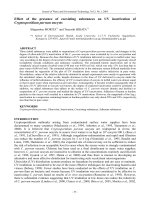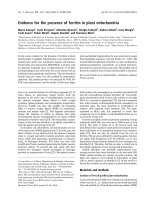Forecasting the presence of hydrocarbon in moc tinh tay prospect, block 05-3, nam con son basin by 3D petroleum system modelling
Bạn đang xem bản rút gọn của tài liệu. Xem và tải ngay bản đầy đủ của tài liệu tại đây (1.68 MB, 8 trang )
PETROLEUM EXPLORATION & PRODUCTION
FORECASTING THE PRESENCE OF HYDROCARBON IN MOC TINH TAY
PROSPECT, BLOCK 05-3, NAM CON SON BASIN BY 3D PETROLEUM
SYSTEM MODELLING
Nguyen Huy Giang1, Le Thi Vu Ngan2
Vietnam Petroleum Institute
2
Bien Dong Petroleum Operating Company
Email:
1
Summary
Moc Tinh Tay is located to the west of the Moc Tinh discovery, Block 05-3, Nam Con Son basin. Results of exploration wells and production
wells clarified the petroleum potential of Block 05-3, especially Moc Tinh area, including Moc Tinh Tay structure.
The purpose of this paper is to understand, by 3D basin modelling, the generation, migration and accumulation histories of oil and gas
from source rock; and evaluate the presence of hydrocarbons in Moc Tinh Tay prospect to minimise the risk of oil and gas exploration in the
study area.
In this study, Lower Miocene and Oligocene source rocks are fair to very good source richness and essentially contain kerogen type III and
a mix of type III and type II and has fair to good gas generation potential. Oligocene source rock has generated hydrocarbon since 24Ma. It is
in oil window at 13Ma, and reached dry gas phase at 10Ma to the present time. The Lower Miocene source rock has generated hydrocarbon
since 12Ma. It is in oil window from 5.5Ma and in gas phase in almost the entire area at the present.
Key words: Petroleum system modelling, Moc Tinh Tay, Petromod software, hydrocarbon potential, Nam Con Son basin.
1. Introduction
The Moc Tinh Tay prospect is located
to the west of Moc Tinh discovery, Block
05-3, central part of Nam Con Son basin.
It consists of two segments, West and
East. The West segment is a faulted threeway dip closure against a large-throw, N-S
trending fault. The East segment is a twoway dip closure against a large throw, NESW trending fault and another small N-S
trending fault at T30 level (Figure 1).
The Tertiary structural history of the Nam Con Son basin, and Block
05-3 in particular, can be divided into distinct episodes of tectonic
activities, namely first rift phase (Eocene - Early Oligocene), intra rift phase
(Late Oligocene - Early Miocene), second extensional phase (Middle
Miocene), and post rift phase (Late Miocene - Pliocene). The Middle
Miocene faulting related to rifting created intensive faulted blocks and
a major structural depression through Block 05-3 and the adjacent areas
[2]. The chrono-stratigraphy chart summarising the history of the Nam
Con Son basin is shown in Figure 2.
The potential of Moc Tinh Tay
structure is proved by the results from
the exploration well in Block 05-3. The
expected reservoir section is fluvio-deltaic
Late Oligocene to Early - Middle Miocene
deltaic/shallow marine sandstones and
turbidite sandstone in the upper syn-rift.
The principal aims of this study are
to evaluate the petroleum system and
estimate the volume of hydrocarbon
accumulations in Upper Miocene turbidite,
Lower Miocene and Oligocene plays
on Moc Tinh Tay structure by 3D basin
modelling.
22
PETROVIETNAM - JOURNAL VOL 10/2015
Figure 1. Moc Tinh Tay location
PETROVIETNAM
2. Model building
2.1. Geometry
To begin with, the present geometry for 3D
Petroleum System Modelling is based on the
input structural model in Petromod, covering an
area in Block 05-3. Geometry (faults and horizons)
modelling for the 3D model incorporates data
from a range of disciplines including regional
geological frame-work, seismic interpretation
as well as wireline, environment and source
rock characteristics. The structural model is built
from simple grid and faults which are converted
to depth domain from seismic interpretation
results correlated with well markers. The
horizontal grid increment is defined by 200 x 200
metre grid (I increment and J increment) due to
a large study area. The fault model is built from
forty-three (43) interpreted faults, in which fault
stick is provided from seismic interpretation
(Figure 3). Moreover, the properties of fault are
assigned into the model that faults opened
during the active time and closed when they
became inactive (Figure 4).
The horizon modelling is the creation of
main stratigraphic horizons based on seismic
interpretation and subdivision of structural
model (Figure 3). The sub-horizons between the
main horizons are conformably followed base
which are constrained by well correlations.
Figure 2. Nam Con Son basin chrono-stratigraphic chart
Figure 3. The 3D view of grids of 10 main horizons derived from seismic interpretations
Figure 4. 43 key faults were selected for building the fault model
PETROVIETNAM - JOURNAL VOL 10/2015
23
PETROLEUM EXPLORATION & PRODUCTION
Table 1. List of interpreted horizons and assigned ages
2.2. Lithology and facies distribution
2.2.1. Stratigraphy/age assignment
Cenozoic stratigraphy in the basin was subdivided
into four major mega-sequences based on tectonic stages
of basin evolution: syn-rift 1, intra-rift, syn-rift 2 and postrift (RN/EPC Joint Study 2012). These mega-sequences
were subdivided into thinner zones equivalent to vertical
resolution of the models. Ages of mega-sequences
were derived from the available biostratigraphic data of
Vietnam Petroleum Institute and other analyses from
different oil/gas companies (Table 1).
Horizons
WB
T100
T90
T80
T65
T30
T20
T10
T00
Nano
Foram
NN3 - NN4 N19 - N20
NN10 - NN11 N15 - N18
NN5 - NN9 N9 - N14
NN2 - NN4 N6 - N8
? - NP24
?
Age
Ma
Holocene
0.0
Pliocene
1.7
Intra Pliocene
2.5
Late Miocene
5.5
Middle Miocene 10.5
Early Miocene
16
Late Oligocene
24.5
? - Early Oligocene 30.0
40.00
5.5
2.2.2. Lithologies/facies definitions
Lithologies used in 3D models were generated by
mixing fundamental lithologies in the Petromod library
e.g. sandstone, shale, and coal, etc. For sandstone, previous
studies suggested that it is mainly arkoses to lithic arkoses
in Folk (1974) [6] classification. The basement mainly
contains granitic intrusive such as granite, granodiorite
with extrusive and metamorphic rocks in places, so in the
Petromod models basement was simply assigned to be
granite (150Ma old).
2.2.3. Facies maps
10.5
Facies map for the area covered by 3D models
have been constructed based on the integration of key
information including the well-log interpretation, the
isopach maps and the depositional frame-work of the
Nam Con Son basin.
2.3. Boundary Condition
2.3.1. Paleo-water depth
The PWD was inferred from the interpreted facies
maps by the following relationships: Delta front-shore
face (0 - 30m); shallower marine (> 30 - 200m) and deep
marine (> 200m). Figure 5 shows the estimated PWD maps
for 3D modelling areas of key events.
16Ma
2.3.2. Sedimentary water interface temperature (SWIT)
Sedimentary water interface temperature or Paleowater interface temperature in this modelling was
extrapolated from pseudo trends created by assigning
the location at latitude 8o, South East Asia to Petromod
software (Figure 6).
2.3.3. Heat flow (1D modelling)
The Nam Con Son basin is a rifting basin, the heat
24
PETROVIETNAM - JOURNAL VOL 10/2015
Figure 5. Paleo water depth (PWD) maps at key events
PETROVIETNAM
Figure 6. Sedimentary Water Interface Temperature (SWIT) at latitude 8o, South East Asia
05.2-HT-1X
05.3-TT-1RRX
05.2-NT-1RX
05.3-CTT-1X
Figure 7. Vitrinite calibration of key wells in Blocks 05-2 & 05-3
PETROVIETNAM - JOURNAL VOL 10/2015
25
PETROLEUM EXPLORATION & PRODUCTION
05.2/10-NT4-1X
05-3-MT-1RX
05.2/10-TA3-1X
05-3-MT-2X
Figure 8. Vitrinite calibration of key wells in Blocks 05-2 & 05-3
flow model is a modification of the classic McKenzie model
(McKenzie, 1978) [1]. The heat flow profiles have been well
calibrated with measured vitrinite reflectance and temperature
values from wells (Figure 7, 8). It can be observed that heat
flow exhibit profiles 2 peaks at 30Ma and 10.5Ma which are
consistent with reliable rifting phases in the Nam Con Son
basin (Figure 9). The recent uprising in heat flow observed
from the 1D modelling is consistent for all modelled wells in
the Nam Con Son basin.
The heat flow trends of 1D models were used to interpolate
the heat flow maps in 3D models.
2.4. Kerogen type and source rock kinetic
For 3D models, main source rocks are swamping shale in
the Oligocene - Lower Miocene sequences, and some lacustrine
source was assumed existing in deep grabens. The input TOC
and in 2D models were determined from the highest frequency
of analysed samples for each source rock formation. Oligocene
swamping deposit is the primary source rock for Nam Con Son
basin with most-likely TOC of 2% and HI of 400mgHC/gTOC.
26
PETROVIETNAM - JOURNAL VOL 10/2015
Figure 9. Boundary conditions used to calibrate temperature and vitrinite
Based on the study of the depositional environment,
the lacustrine source rock may be limited. In addition,
coal was encountered at near top T20 sequence such
PETROVIETNAM
as in LD-1X, NT4-1X wells with the total thickness up to
20m. The averaged TOC (av. 53.84%) and HI (av. 224) were
used for the coal layers. The organic richness of T30 shale
seems to be poor with most-likely TOC of about 1% and HI
of 300mgHC/g TOC.
With the organofacies concept of Oligocene and Early
Miocene mentioned above, it can be seen that the source
rocks in the study area mainly consist of type III kerogen and
minor type II/III deposited in the swamping environment.
For that reason, compositional kinetic models named
Handil_Mahakam Delta; IES_TIII_Tertiary_Coal_4C were
selected for Oligocene - Lower Miocene shale and coal.
3. Modelling results
3.1. Maturity of source rock
In basin analysis studies, vitrinite is used to calibrate
the burial and thermal history models as well as
hydrocarbon generation. The approach to determination
of vitrinite-reflectance value is using temperature and
measured Ro of key wells to calibrate modelled maturity.
The 3D modelling results show the detailed maturity
level of all potential source rocks in Block 05-3. Modelled
Ro maps indicate that the Oligocene (T20 sequence)
T20_4 (Top Basement)
section is mature for generation and expulsion of wet to
dry gas in the study areas (Figure 10). In fact, the maturity
maps point out the T20 source rock located at the central
area completely entered the dry gas phase (red colour),
while due to burial depth source rock at Moc Tinh and Tho
Tinh well is now wet gas (blue colour) in top T20.
At shallower stratigraphy levels T30 - Lower Miocene
source rocks entered the oil window to the dry gas phase
over most of Block 05-3. The T30 sequence was split into 4
subzones named T30-4; T30-3; T30-2 and T30-1 (Top T30)
in the 3D Petromod models. Due to the influence of the
depositional environment (shore - face sand and shallow
marine) in upper parts T30, the lowermost part of the
sequence T30-4 was considered as Lower Miocene source
rock (Figure 11).
3.2. Timing of hydrocarbon generation and expulsion
Based on extracted 1D models combined with the
cumulative generation curve (Figure 12), it can be clearly
seen that T30 source rock has generated HC since 12Ma in
the central area while T20 SR has generated HC since 24Ma
in the central area and migration phase was widespread
from 15Ma to 8Ma. In fact, the increase in maturity level
of Oligocene source rock is not stable; it is commonly
T20_3
Main fetch area of MT
T20_1 (Coal Layer)
T20_2
Figure 10. Modelled vitrinite reflectance for T20 source rock
PETROVIETNAM - JOURNAL VOL 10/2015
27
PETROLEUM EXPLORATION & PRODUCTION
T30_4
T30_3
Main fetch area of MT
T30_1 (top T30)
T30_2
Figure 11. Modelled vitrinite reflectance for T30 source rock
T30 Source Rock
T20 Source Rock
speeded up during rifting phases or high heat flow phases. This
explains why during the Early Miocene the generation was not
much changed, but it significantly increased during the Middle
Miocene (16 - 10.5Ma).
Moreover, Lower Miocene source rock started to generate
hydrocarbon since 12Ma. At that time, this source rock was in the
early mature stage. The main oil generation time of this source
rock is from 5.5Ma to present.
3.3. Hydrocarbon migration and accumulation
Together with the source rock potential and maturity, the
effectiveness of migration is a key factor deciding the exploratory
success or failure [5].
1D depth extraction at central trough, study area - burial
maturity (Ro) history
Figure 12. Cumulative generation and expulsion of source rock layers in Block 05-3
28
PETROVIETNAM - JOURNAL VOL 10/2015
3D Model accumulation volume or fluid composition
outputs can be compared with the information at discovery
wells of Block 05-3 and the model can be adjusted to improve
the match. Figure 13 shows that flow path lines for all levels, all
accumulations, with Oligocene TR map underneath; fault (gray
colour) provides a preferential migration pathway.
Firstly, the accuracy of simulation was proven by matching
at discovery wells (the wells in Moc Tinh fields). Most Oligocene
source rock is in gas prone at present, so it is reasonable to explain
why the accumulations in Moc Tinh discovery are condensate
and dry gas (CH4).
PETROVIETNAM
rock properties and the aspects of in-fault migration.
The results show that:
MT cluster
• The Oligocene, Lower Miocene sedimentary
layer contains mainly kerogen type III and a mix of
kerogen type III and I. The Oligocene, Lower Miocene
source rocks have got enough organic matter richness
for HC generating.
• Hydrocarbon generation potential: Main source
rock (Oligocene & Lower Miocene) is mainly located in
the centre trough and in gas prone at present.
• Migration and charge: Hydrocarbon was
expelled since 24Ma from Oligocene T20 SR which
widely migrated from 15 to 8Ma.
Figure 13. Flow path lines for all levels, all accumulation in study area
• Main accumulation in prospect Moc Tinh Tay is
in T50 and T30 layers. No accumulation in Oligocene
sandstones due to low porosity.
• Uncertainties of model: the presence and
amount of HC accumulations depend on time-depth
conversion; sample grid; and fault properties.
Figure 14. Hydrocarbon migration and accumulation in Moc Tinh and Tho Tinh prospect-2D basin
modelling
To increase the accuracy of basin modelling, the 2D migration
and accumulation model is simulated. Based on 2D modelling
results, the charge system in the central part of the Nam Con
Son basin is dominated by vertical migration through faults and
imperfect intra formation seals. Moreover, Moc Tinh and Moc Tinh
Tay structures can be charged with higher column height of gas
and condensate (Figure 14).
The modelling results of 3D petroleum system modelling
show possible significant accumulations in T50, and T85
reservoir levels in the Moc Tinh Tay structure. Besides, it is
predicted that the parts of T30 sequence on the Moc Tinh Tay
structure have been charged by minor amount of oil and gas.
4. Conclusions and recommendations
In this study, detailed 1D, 2D, and 3D modelling of
petroleum system in Block 05-3 has been carried out. The
inputs for the modelling have been integrated from various
investigations on structural development, paleo-depositional
environment, heat-flow calibration, top seal calibration, source
In general, the findings from basin modelling
reveal that Moc Tinh Tay prospect can be charged
from source rock in surrounding areas with significant
amount. To reduce investment risk in oil and gas
exploration in Block 05-3, further studies including
verification of facies and lithology distribution at
Moc Tinh Tay prospect by seismic inversion are
recommended.
References
1. Thomas Hantschel, A.I. Kauerauf. Fundamentals
of basin and petroleum systems modeling. Springer
Berlin Heidelberg. 2009.
2. Talisman Joint Study. The tectonic and
stratigraphic development of the Nam Con Son and
Vung May basins. Final report. 2011.
3. BP sub-Surface team. Block 05-3 Moc Tinh
reserves report. 2006.
4. J.J.Sweeney, A.K.Burnham. Evaluation of a
simple model of vitrinite reflectance based on chemical
kinetics. AAPG Bulletin. 1990; 74: p. 1559 - 1570.
5. G.R.Beardsmore, J.P.Cull. Crustal heat flow:
A guide to measurement and modelling. Cambridge
University Press. 2001.
6. R. L. Folk. Petrology of Sedimentary Rock.
Hemphill Publishing Company, Austin, Texas. 1974.
PETROVIETNAM - JOURNAL VOL 10/2015
29









